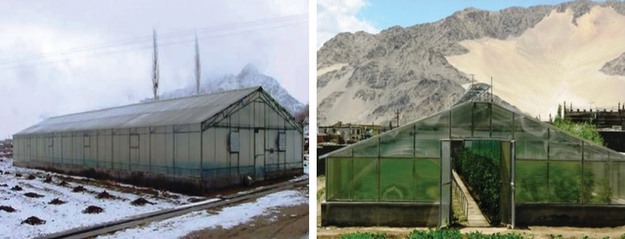Ladakh's Trans-Himalayan Cold arid high altitude region, known for its hostile climatic conditions with temperatures plummeting as low as -45°C, has long faced the challenge of providing fresh food to its inhabitants. Located on the international borders of China and Pakistan, the region holds strategic importance, resulting in a large deployment of Army personnel. However, due to the extreme weather conditions, the region remains cut off from the outside world for nearly 6-8 months during winter, leading to a severe shortage of fresh food.
Recognizing the pressing need to address this issue, researchers have delved into the possibility of utilizing solar energy to maintain suitable temperatures within enclosed structures during the peak winter season, thereby enabling fresh food production. The Trans-Himalayan region of Ladakh boasts an abundance of solar energy, ranking fourth in India in terms of irradiation, making it an ideal candidate for harnessing this renewable resource.
Between 2016 and 2019, a groundbreaking initiative successfully demonstrated the production of a variety of fresh foods within the coldest and largest existing structure in the region. Commercially available heating units powered by a solar PV-based system were used to maintain the required temperature. The project yielded an average production of 1500kgs-1800kgs of fresh vegetables during the peak winter period, marking the first time such produce was made available in the region.
The survival rate of the crops within the structure ranged from an impressive 92.5% to 100%, highlighting the effectiveness of the technology. With an area of 36,002 square feet, this innovative approach has paved the way for large-scale fresh food production in the region during the most challenging weather conditions.

The implications of this achievement extend beyond combating food shortages. By reducing the dependence on packaged food containing preservatives and harmful chemicals, the health of the local inhabitants is expected to improve significantly. The unavailability of fresh food has long caused nutritional deficiencies among the population, resulting in various health issues. With the implementation of solar-powered temperature control systems, the region has witnessed a remarkable step towards ensuring a healthier diet for its residents.
The success of this initiative has generated optimism among the residents of Ladakh, offering a glimmer of hope for improved food security during the harsh winter months. Additionally, the use of renewable energy sources aligns with global efforts to combat climate change and reduce carbon emissions, making this a significant development in sustainable agriculture practices.
As researchers continue to refine and expand this innovative approach, it is anticipated that the production of fresh food within enclosed structures powered by solar energy will gradually become a vital component of Ladakh's winter survival strategies. The integration of modern technology with traditional agricultural practices promises to transform the lives of the region's inhabitants, ensuring a more secure and sustainable future.
